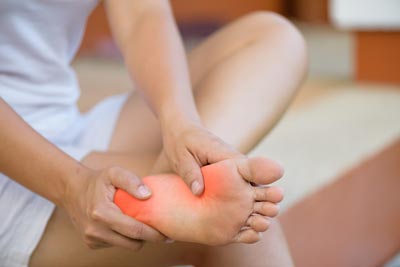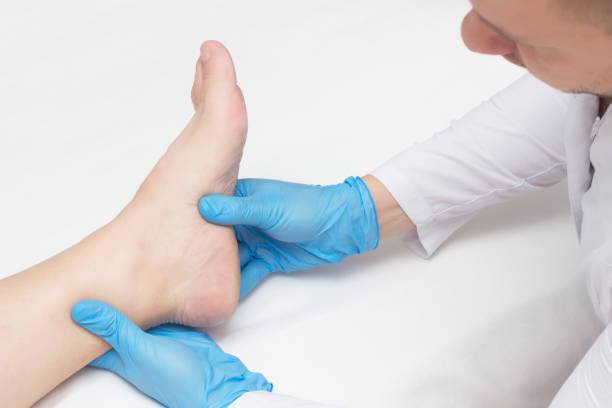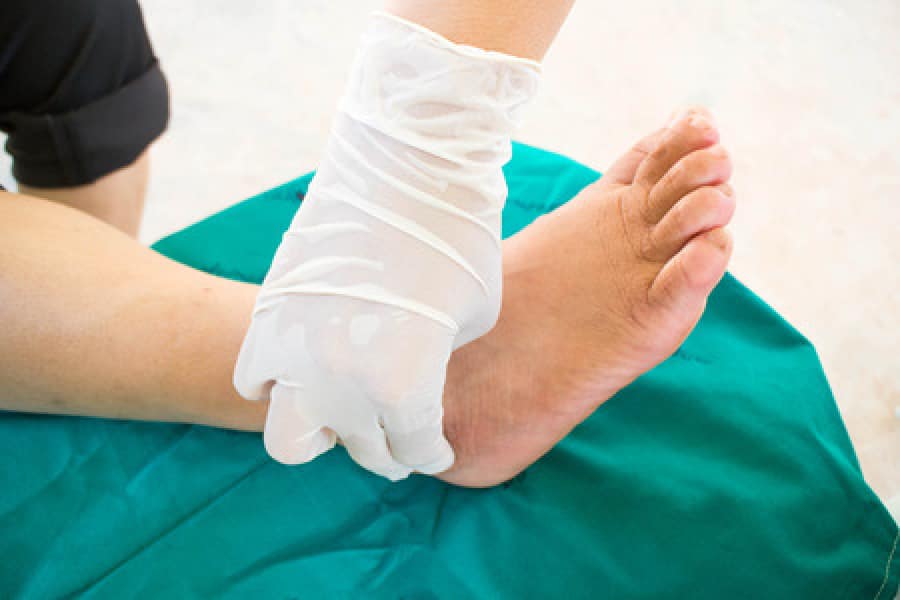Ankle Pain without an Injury: Exploring Underlying Causes
Ankle pain, though often attributed to twists and sprains, can sometimes be an enigmatic discomfort, creeping up without an obvious cause or injury. For the unsuspecting individual, a simple walk or shift in weight might trigger a sharp pain or persistent ache—a sign that something beneath the surface isn’t quite right.
In this overview, we’ll unpack the complexities of non-traumatic ankle pain, understanding what may lie beneath its surface and how to address it effectively. Whether you’re an active adult dealing with a mystery ache or a casual stroller wondering about that intermittent discomfort, this post is for you.
Understanding Ankle Pain – A Look at the Anatomy and Mechanics of the Ankle
The human ankle is a marvel of design, composed of an intricate network of bones, tendons, ligaments, and muscles that work harmoniously to support our body weight and facilitate motion. When this delicate balance is disrupted, even slightly, it can lead to ankle pain.

Ankle Pain
Anatomy Lesson
The ankle is a hinge joint, which means it primarily moves in only one direction—up and down, like a hinge on a door. This simplicity is deceptive, however, as the ankle is a pivot for a much more complex motion, acted upon by the foot, leg, and the arc of the gait itself. Any irregularity in these components can lead to increased stress and eventual pain.
Mechanics at Play
The ankle’s job is varied. It needs to absorb shock as we walk, run, or jump, and it has to flex and rotate in response to our movements. Each of these actions is a potential source of strain, especially if our gait is off-balance or we are pushing ourselves too hard. The muscles and ligaments in the ankle are numerous, but they are also relatively small and can be overwhelmed if they are not operating at full capacity.
Common Causes of Ankle Pain without Injury
While the precise origin of ankle pain without an apparent injury can be elusive, several common conditions often play a significant role. Understanding these can illuminate potential pathways to relief:
- Arthritis: One of the most prevalent causes of ankle pain is arthritis. Osteoarthritis, resulting from wear and tear over the years, can affect the ankle, causing pain and stiffness. Rheumatoid arthritis, an autoimmune condition, can also target the ankle, leading to swelling and discomfort.
- Tendonitis: This condition involves inflammation of the tendons, which are the thick fibrous cords that attach muscle to bone. Tendonitis in the ankle often results from overuse or repetitive motion, leading to pain and tenderness around the joint.
- Gout: Gout is a form of inflammatory arthritis that can cause sudden, severe attacks of pain, redness, and tenderness in the joints. The ankle can be one of the affected areas, especially if one has a diet high in purines—substances found in red meat and certain types of fish—which can lead to urate crystals in the joints.
- Nerve Compression: Conditions such as tarsal tunnel syndrome involve the compression of nerves in the ankle and can lead to pain, tingling, and numbness. This condition can be exacerbated by repetitive strain or anatomical variations that put pressure on the nerves.
- Flat Feet or Fallen Arches: The absence of a normal arch in the foot can lead to an uneven distribution of body weight, which can stress the ankles and cause pain. This condition can be congenital or develop over time due to weakened tendons.
- Bursitis: Inflammation of the bursae, small fluid-filled sacs that cushion the bones, tendons, and muscles near the joints, can lead to pain and stiffness in the ankle. Bursitis often results from repetitive motion or pressure on the ankle.
Understanding the underlying cause of ankle pain without injury is crucial for effective treatment. Each of these conditions has specific interventions that can reduce pain and improve functionality, making an accurate diagnosis a critical step on the path to recovery.
Diagnosing and Treating Ankle Pain
Diagnosing the exact cause of ankle pain without an obvious injury entails a comprehensive approach that combines medical history, physical examination, and possibly imaging tests. During the initial consultation, healthcare professionals will inquire about the nature of the pain, its onset, and any activities that exacerbate or alleviate the discomfort. A physical examination allows the doctor to assess the ankle’s range of motion, swelling, and tenderness, pinpointing areas of concern.
Imaging Tests for a Clearer Picture
In some cases, further diagnostic tests may be necessary to identify the underlying cause of the ankle pain. These can include:
- X-rays: To detect bone fractures, signs of arthritis, and changes in joint space.
- MRI (Magnetic Resonance Imaging): Offers a detailed view of the ankle’s soft tissues, including muscles, ligaments, and tendons, to identify tears, inflammation, or other abnormalities.
- Ultrasound: Utilized to visualize soft tissue structures and assess the integrity of tendons and ligaments.
- CT Scan (Computed Tomography): Provides a highly detailed, cross-sectional view of the ankle, useful in diagnosing complex bone issues.
- Treatment Options: The treatment for ankle pain without injury depends largely on the diagnosed condition. Common treatment modalities include:
- R.I.C.E. Method: Rest, Ice, Compression, and Elevation is a self-care strategy for minor ankle pain, aimed at reducing swelling and discomfort.
- Physical Therapy: A tailored physical therapy program can help strengthen the ankle, improve flexibility, and correct biomechanical irregularities, reducing stress on the joint.
- Medications: Nonsteroidal anti-inflammatory drugs (NSAIDs) can relieve pain and reduce inflammation. In some cases, corticosteroid injections may be recommended to decrease severe inflammation.
- Orthotic Devices: Custom orthotics or supportive footwear can alleviate pain by correcting gait abnormalities and redistributing pressure away from the affected area.
- Surgery: In cases where conservative treatments fail to provide relief, or the underlying cause is structural, surgical intervention may be necessary to repair or correct the issue.
Implementing the right treatment plan requires a careful and thorough diagnosis. Consistency in following the prescribed treatment and ongoing communication with the healthcare provider are key to managing ankle pain and regaining full functionality.

Ankle Pain
When to Seek Medical Attention for Ankle Pain
While some ankle pain can be managed at home through rest and over-the-counter treatments, there are certain situations where seeking medical attention is crucial. Timely intervention can prevent further damage and ensure a more effective treatment plan. Consider consulting a healthcare professional if you experience any of the following:
- Persistent Pain: If your ankle pain does not improve with rest and home treatments within a few days, or if the pain worsens, it’s essential to seek medical advice.
- Severe Swelling and Redness: Swelling and redness that intensifies or does not subside could indicate an infection or more serious injury, requiring prompt medical evaluation.
- Inability to Walk or Bear Weight: Difficulty in walking, bearing weight on the affected foot, or significant limping necessitates a medical evaluation to rule out severe conditions like fractures.
- Deformity in the Ankle Region: Any visible deformity or abnormality in the shape of the ankle or foot should be assessed by a healthcare provider as it may indicate a serious injury or condition.
- Signs of Infection: If you notice symptoms such as warmth, fever, or streaks of red extending from the affected area, you may have an infection that requires immediate medical treatment.
- Numbness or Tingling: These sensations, especially if persistent, can indicate nerve damage or compression and should not be ignored.
Recognizing when to seek medical attention can be the difference between a quick recovery and long-term issues. If you’re uncertain about the severity of your ankle pain or how to manage it, consulting a healthcare professional is always the best course of action.
Prevention Strategies for Non-Traumatic Ankle Pain
Preventing non-traumatic ankle pain involves a combination of lifestyle adjustments, physical activities, and preventative measures to strengthen and protect the ankle joint. Here are some effective strategies to help reduce the risk of developing ankle pain without injury:
- Maintain a Healthy Weight: Extra weight puts additional pressure on your ankles and can lead to pain and discomfort. Achieving and maintaining a healthy weight through a balanced diet and regular exercise can significantly reduce the stress on your ankles.
- Strengthen and Stretch: Regular exercises that strengthen the muscles around your ankles and improve your flexibility can help protect your ankles from pain and injury. Incorporating ankle-strengthening exercises and stretches into your routine can improve your joint stability and range of motion.
- Wear Proper Footwear: Shoes that provide adequate support and fit well are crucial in preventing ankle pain. It’s especially important to choose the right shoes for your specific activities. For instance, runners should opt for running shoes that offer good arch support and cushioning.
- Avoid Repetitive Stress: Activities that put repetitive stress on the ankles can increase the risk of pain and injury. Varying your workout routines and incorporating low-impact exercises like swimming or cycling can help minimize this risk.
- Practice Good Posture: Poor posture can lead to imbalances in your body, putting unnecessary strain on your ankles. Being mindful of your posture and working to improve it can help distribute your body weight more evenly, reducing the burden on your ankles.
- Warm-Up Before Activities: Engaging in a proper warm-up before physical activity prepares your muscles and joints, including your ankles, for the increased demand, reducing the risk of pain and injuries.
By implementing these prevention strategies, individuals can significantly reduce their risk of non-traumatic ankle pain, promoting better overall ankle health and mobility.
The Role of Physical Therapy in Managing Ankle Pain
Physical therapy plays a pivotal role in the effective management and rehabilitation of ankle pain. A dedicated physical therapy program, designed and supervised by a qualified physical therapist, can significantly expedite recovery, enhance functionality, and mitigate the risk of future injuries. The primary goals of physical therapy for ankle pain include:
- Reducing Pain and Swelling: Through the application of therapeutic modalities such as ice, heat, ultrasound, and electrical stimulation, physical therapists can effectively alleviate pain and reduce swelling in the affected area.
- Improving Range of Motion: Stiffness in the ankle can be a significant barrier to recovery. Customized stretching exercises are introduced to gently increase the flexibility and range of motion in the ankle joint.
- Strengthening Exercises: Strengthening the muscles around the ankle is crucial. A structured exercise program targeting these muscles helps to provide better support for the ankle, enhancing stability and preventing future injuries.
- Balance and Proprioception Training: Poor balance and proprioception (the sense of joint position) are common after ankle injuries. Physical therapists employ specialized exercises to improve these aspects, which are vital for preventing re-injury.
- Education and Lifestyle Modification: Physical therapists not only work on the physical aspects of rehabilitation but also educate patients on lifestyle modifications and ergonomic adjustments to prevent recurrence. This includes advice on proper footwear, workplace ergonomics, and activity modification.
By addressing the underlying causes of ankle pain and equipping patients with the tools and knowledge for home-based care, physical therapy ensures a holistic approach to recovery, setting the foundation for a return to pain-free, normal function and activity levels.

Ankle Pain
Alternative Therapies for Ankle Pain Relief
In addition to traditional medical and physical therapy treatments for ankle pain, several alternative therapies can provide relief and aid in the healing process. Many individuals find these non-invasive approaches beneficial, especially when used in conjunction with conventional treatments. Here’s a look at some alternative therapies for managing ankle pain:
- Acupuncture: This ancient Chinese therapy involves inserting thin needles into specific points on the body. Acupuncture aims to restore balance and stimulate the body’s natural healing mechanisms. It may be particularly effective for reducing pain and inflammation.
- Massage Therapy: Therapeutic massage can help alleviate muscle tension, improve circulation, and reduce swelling around the ankle. It can also promote relaxation and well-being, which aids in the overall healing process.
- Hydrotherapy: Utilizing water’s therapeutic properties, hydrotherapy exercises performed in a pool can be very gentle on the joints while providing resistance for strengthening. Warm water may also help to reduce pain and stiffness in the ankle.
- Yoga and Pilates: Both practices emphasize strength, flexibility, balance, and body awareness, making them ideal for rehabilitation and prevention of ankle pain. Certain poses and exercises can be modified to accommodate your comfort level and improve ankle stability.
- Chiropractic Care: Chiropractors can offer treatments that focus on the body’s alignment, which may include gentle manipulations of the foot and ankle. This can help improve joint function and reduce pain.
- Herbal Remedies and Supplements: Some individuals find relief from ankle pain through natural supplements and herbs known for their anti-inflammatory properties, such as turmeric, ginger, and omega-3 fatty acids. It’s essential to consult with a healthcare provider before starting any new supplements.
Before trying any alternative therapies, it’s crucial to consult with a healthcare professional to ensure they are appropriate for your specific situation and won’t interfere with any existing treatments.
In conclusion, preventing ankle pain through proper precautions and seeking treatment from a physical therapist can significantly improve overall ankle health and reduce the risk of future injuries. Alternative therapies can also provide relief and support in conjunction with traditional treatments. By taking care of our ankles, we can maintain an active lifestyle and enjoy pain-free movement for years to come.
Flagstaff Foot Doctors: Anthony Rosales DPM
https://www.google.com/maps?cid=8835841318590452161
421 N Humphreys St, Flagstaff, AZ 86001, United States
(928) 774-4825
https://flagstafffootandankle.com/
